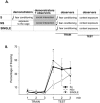Social modulation of learning in rats
- PMID: 20042480
- PMCID: PMC3960044
- DOI: 10.1101/lm.1670910
Social modulation of learning in rats
Abstract
It is well known that emotions participate in the regulation of social behaviors and that the emotion displayed by a conspecific influences the behavior of other animals. In its simplest form, empathy can be characterized as the capacity to be affected by and/or share the emotional state of another. However, to date, relatively little is known about the mechanisms by which animals that are not in direct danger share emotions. In the present study, we used a model of between-subject transfer of fear to characterize the social interaction during which fear is transmitted, as well as the behavioral effects of socially transmitted fear. We found that (1) during social interaction with a recently fear-conditioned partner, observers and demonstrators exhibit social exploratory behaviors rather than aggressive behaviors; (2) learning and memory in a shock-motivated shuttle avoidance task are facilitated in rats that underwent a social interaction with a partner that had been fear conditioned; and (3) a brief social interaction with a recently fear-conditioned partner immediately before fear conditioning increases conditioned freezing measured on the next day. The observed effects were not due to a stress-induced increase in pain sensitivity or analgesia. Collectively, these data suggest that a brief social interaction with a cage mate that has undergone an aversive learning experience promotes aversive learning in an otherwise naïve animal. We argue that socially transferred fear is an adaptation that promotes defensive behavior to potentially dangerous situations in the environment.
Figures




References
-
- Barnett SA. Ecology. In: Whishaw IQ, Kolb B, editors. The behavior of the laboratory rat. Oxford University Press; New York: 2005. pp. 15–24.
-
- Church RM. Emotional reactions of rats to the pain of others. J Comp Physiol Psychol. 1959;52:132–134. - PubMed
-
- de Waal FB. Putting the altruism back into altruism: The evolution of empathy. Annu Rev Psychol. 2008;59:279–300. - PubMed
Publication types
MeSH terms
LinkOut - more resources
Full Text Sources
